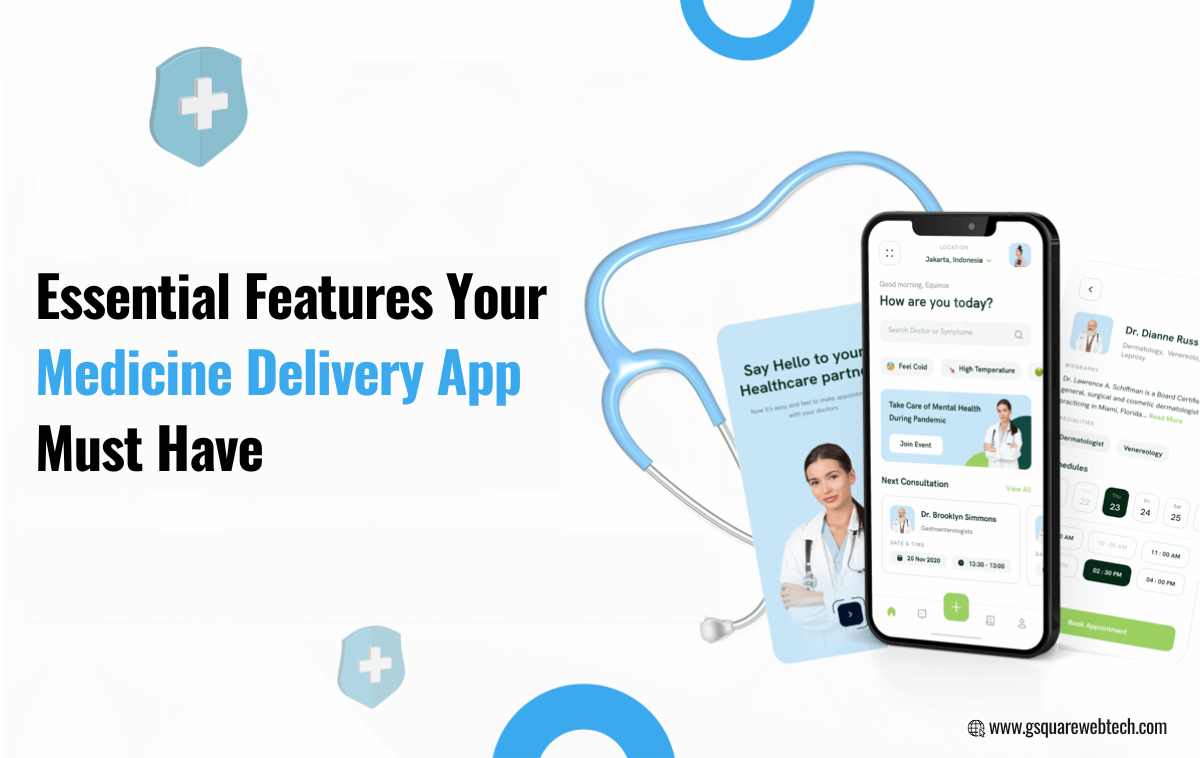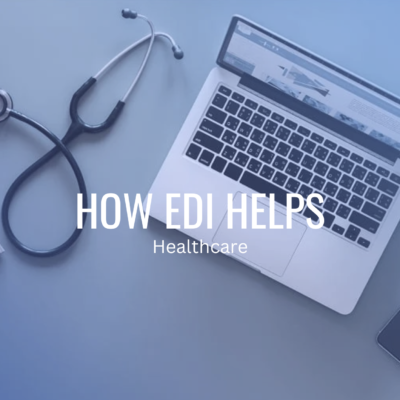
Essential Features Your Medicine Delivery App Must Have
In recent times, a big change is how healthcare is becoming digital. A key part of this change is apps that deliver medicine to people’s homes. By 2028, the global market for digital health is expected to be worth over $275 billion, showing that more and more people are using mobile solutions for healthcare.
People are liking medicine delivery apps more because they’re easy to use. With these apps, you can see, order, and have medicine delivered to your door without going out. In this guide, we’ll talk about the important features you need for a medicine delivery app made for pharmaceutical businesses.
The Essential Features Of A Medicine Delivery App
To make a medicine delivery app stand out and compete well, owners need to include certain features. These features not only make the app work better but also build trust with customers, which is crucial in a competitive market like this. It’s important to consider these features when estimating the cost of developing your healthcare app, as they can affect the overall budget based on their number and complexity.
User friendly UI (User Interface):
One crucial aspect is having a user-friendly interface (UI). Although not a feature per se, a consistent UI is essential for improving usability and making interactions smooth. A good UI makes it easy for users to navigate through available medications, place orders, and track deliveries. Clear design elements and visually appealing graphics contribute to a positive user experience and encourage continued app usage. The UI is a vital component of any medicine delivery app.
Authentication Security:
Because healthcare information is highly sensitive, it’s crucial to have strong authentication systems in place to safeguard user data. Secure login systems, including biometric authentication and two-factor verification, help prevent unauthorized access to personal information. App owners must ensure these security measures are in place to comply with data protection regulations and build trust with users.
Medicine Catalog:
Another important feature of a medicine delivery app is a comprehensive catalog of medications. This catalog should include a wide range of medicines to meet various user needs. App owners should partner with reputable pharmacies and healthcare providers to ensure both prescription and over-the-counter medications are available. A well-organized catalog with detailed product information helps users make informed decisions, leading to higher satisfaction with the app.
Prescription Upload:
Allowing users to easily upload their prescriptions digitally is a helpful feature. This integration streamlines the ordering process by enabling automatic submission of prescriptions, bypassing the need for manual submission. App owners must prioritize data protection for users’ private medical information and comply with regulatory requirements for electronic prescriptions.
Real-time Order Tracking:
Real-time order tracking lets users see changes in their deliveries instantly, increasing transparency. It provides timely updates on order fulfillment and delivery, reducing anxiety about waiting for medication. Integration with GPS tracking ensures accurate location information, leading to precise delivery estimates and higher user satisfaction.
Real-time Inventory Management:
Efficient inventory control ensures medication availability and prevents stockouts or delays. Monitoring inventory in real-time enables proactive replenishment, avoiding service delays and ensuring smooth supply chain management. App owners should use technology like RFID tagging and automated inventory alerts for efficient inventory processing.
Secure Payments:
Secure payment processing protects user financial information and enables seamless transactions. Encryption protocols and compliance with PCI DSS standards ensure payment data confidentiality and integrity. Offering various payment options and integrating well-known payment gateways enhances user convenience, increasing conversion rates.
Profile Management:
Allowing users to create and manage profiles improves personalization and minimizes interaction hassles within the app. Personalization through user profiles, order history, and preferences enables tailored recommendations. App owners should prioritize data protection and user information control to ensure user trust and safety.
Refill Reminder and Automation:
Including refill reminders in the app helps users stick to their medication schedules, reducing missed doses. Automated reminders based on prescription timelines or user preferences improve medication adherence and lead to better health outcomes. App owners can use push notifications or text message alerts to remind users when refills are due, ensuring continuity of care and business success.
AI-enabled Chatbot:
AI-powered chatbots offer personalized assistance and guidance to users, enhancing app usage. These virtual assistants can provide information about medications, answer user queries, and offer guidance on health-related issues. Natural language processing capabilities enable chatbots to converse naturally and meet user needs effectively. This feature is relatively new in medical delivery apps, making it a valuable addition to enhance user experience.
Offline Accessibility:
Offline accessibility ensures vital functionalities and information are available even without an internet connection, providing consistency in user experience. Users can access medication catalogs, check order history, and receive critical notifications offline. App owners should develop offline features that synchronize with the online platform, offering an integrated user experience regardless of connectivity. Progressive Web Apps (PWAs) can be a solution for this.
Data Privacy:
Strict measures must be implemented to protect users’ data, especially confidential medical information. Secure data encryption, access control mechanisms, and anonymization methods safeguard sensitive information from misuse or hacking. Regular audits of data handling practices by app owners ensure compliance with medical standards, preserving user trust and confidence.
Medical Compliance:
Adherence to medical standards and regulations (such as DICOM, HIPAA, and HL7) is essential for maintaining app authentication and trustworthiness. App owners should collaborate with healthcare professionals and regulatory bodies to ensure compliance with medicine dispensing rules. Providing accurate medication information, dosage instructions, and contraindications fosters user responsibility in safe medication use.
Offers/Discounts:
Incentives like discounts, promotions, and loyalty rewards encourage user participation and promote brand loyalty. App owners can offer targeted deals based on user preferences, purchase history, or prescription trends to encourage repeat purchases. Following successful models like CVS pharmacy highlights the importance of rewards and discounts in building customer loyalty. These features enhance the value proposition of the online pharmacy app, increasing sales and fostering a loyal customer base through word-of-mouth publicity.
Wearable Device Integration:
Incorporating wearables allows continuous health monitoring and medication tracking. Devices like health bands and smartwatches record vital signs and medication intake, providing valuable insights into user behavior. Integration with widely used smart wearables through APIs and interoperability standards enhances app functionality and user satisfaction.
Easy Search/Categorization:
Convenient search and categorization functions help users find specific medications or products quickly. Features like filters, sorting options, and predictive search improve content discoverability and speed up decision-making. App owners should prioritize usability and accessibility to ensure a satisfying user experience and retention.
Estimated Time of Delivery (ETD):
Providing accurate delivery time estimates helps users plan their medication needs. Real-time tracking integration with logistics systems enables on-the-fly delivery time calculation. App owners should communicate precise delivery estimates to users and promptly update them on any delays or changes to ensure transparency.
Price Comparison:
Including price comparison features allows users to make informed purchasing decisions. Comparing prices from different drugs and pharmacies provides cost-saving options. App owners can integrate APIs or third-party services to access real-time pharmaceutical pricing information, enhancing the app’s value and utility for users.
History of Orders:
Maintaining a detailed order history enables users to track purchases and reorder products conveniently. Viewing order history, invoices, and receipts enhances transparency and trust. App owners must ensure the accuracy of data and implement strong storage and retrieval mechanisms for easy access to order history.
Analytics Reports:
Data analytics capabilities enable app owners to utilize user behavior and preferences for decision-making. Analyzing interactions, purchase patterns, and medication trends informs strategic market opportunities. Owners can optimize app functionality and improve user experience, engagement, and business development using analytics reports.
Reviews/Feedback:
User reviews and feedback contribute to community engagement and app improvement. Introducing a rating and review system allows users to share experiences and suggestions. Responding to negative feedback promptly demonstrates owners’ commitment to customer satisfaction.
Tax Calculation/Estimated Costs:
Clear pricing, including taxes and fees, helps users calculate medication costs accurately. Integration of tax calculation lets users see order costs upfront, avoiding surprises at checkout. Compliance with tax regulations and clear explanations of price components ensure transparency and trust in medicine delivery apps.
Multilingual:
Offering multiple languages enhances accessibility and inclusivity, allowing diverse audiences to use medicine delivery apps. Users can interact with app content and obtain support in their preferred language, improving user experience. Localization efforts prioritize providing a universal experience for global users, enhancing app accessibility.
Loyalty Program:
Loyalty programs reward users for ongoing utilization and purchases, encouraging repeat business and brand loyalty. Points, discounts, or privileges for frequent users increase retention and expand the user base. Customizable loyalty programs optimize engagement and satisfaction by catering to various user preferences.
QR Code Scanner:
A QR code scanner simplifies medication verification and authentication, ensuring safety and efficiency in ordering. Users can scan QR codes on prescription labels or product packaging to obtain information and verify product details. App owners must ensure compatibility with common QR code formats and scanner performance for accuracy and reliability.
Embedded CRM (Customer Relationship Management):
CRM capabilities allow app owners to manage customer interactions and relationships effectively. Features like user profiles, communication logs, and feedback tracking enable targeted engagement and personalized support. CRM data segmentation helps target marketing campaigns and deliver personalized experiences, increasing consumer satisfaction and driving loyalty.
Multi-currency Support:
Supporting multiple currencies facilitates international transactions and expands the app’s usability. Currency conversion and displaying prices in the user’s desired currency streamline the buying process for international users. App owners must ensure accurate currency conversion and compliance with financial regulations for seamless cross-border transactions.
Ads:
Monetizing through targeted ads allows app owners to earn revenue while benefiting consumers. Personalized ads based on user demographics and browsing history increase ad effectiveness and app engagement. App owners should prioritize user experience and carefully balance ad promotion to avoid reducing usability and satisfaction.
Push Notifications:
Push notifications deliver real-time updates, offers, and reminders to users’ smartphone screens. Personalized notifications based on user preferences, order status, or medication reminders increase engagement and app usage. Analytics help optimize the timing, frequency, and content of push notifications, improving user engagement and retention.
Conclusion
In conclusion, a successful medicine delivery app must prioritize essential features to meet user needs while ensuring usability and compliance with regulatory standards. By focusing on user-friendly UI design, robust security measures, a comprehensive medication catalog, and personalized user experiences, the app becomes a valuable solution that enhances access to essential healthcare services.
Following the path of researching medicine delivery app development solutions and incorporating critical features while prioritizing user-centric design is crucial for effective performance in a competitive healthcare application market. While the development budget may vary based on the desired functionality, prioritizing key functionalities is essential for driving user engagement and building trust, ultimately leading to long-term success in the dynamic healthcare landscape.







